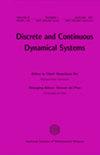Linearization of a nonautonomous unbounded system with hyperbolic linear part: A spectral approach
IF 1.1
3区 数学
Q1 MATHEMATICS
引用次数: 0
Abstract
Palmer's linearization theorem states that a hyperbolic linear system is topologically conjugated to its bounded perturbation. Recently, Huerta (DCDS 2020 [8]), Castañeda and Robledo (DCDS 2018 [3]) and Lin (NA 2007 [13]) generalized Palmer's theorem to the linearization with unbounded perturbation (continuous or discrete) by assuming that the linear part of the system is contractive or nonuniformly contractive. However, these previous works sacrifice the hyperbolicity of the linear part. Is it possible to study the linearization with unbounded perturbations in the hyperbolic case? In this paper, we improve the previous works [3,8,13] to the hyperbolic unbounded systems. For the contraction, each trajectory crosses its respective unit sphere exactly once. However, for the hyperbolic system, either the trajectory does not cross the unit sphere, or the trajectory cross it twice. Thus, the standard method used in the previous works for the contractive case is not valid for the hyperbolic case yet. We develop a method to overcome the difficulty based on two 'cylinders'. Furthermore, quantitative results for the parameters are provided.具有双曲线性部分的非自治无界系统的线性化:谱方法
帕尔默线性化定理指出一个双曲线性系统是拓扑共轭于它的有界摄动的。最近,Huerta (DCDS 2020 [8]), Castañeda和Robledo (DCDS 2018[3])和Lin (NA 2007[13])通过假设系统的线性部分是收缩或非均匀收缩,将Palmer定理推广到具有无界摄动(连续或离散)的线性化。然而,这些先前的作品牺牲了线性部分的双曲性。有没有可能研究双曲情况下无界扰动的线性化?本文将前人的研究成果[3,8,13]改进到双曲无界系统。对于收缩,每条轨迹正好穿过它各自的单位球一次。然而,对于双曲系统,要么轨迹没有穿过单位球,要么轨迹两次穿过单位球。因此,在前面的工作中使用的标准方法的收缩情况是无效的双曲情况。我们开发了一种基于两个“圆柱体”的方法来克服困难。此外,还给出了参数的定量结果。
本文章由计算机程序翻译,如有差异,请以英文原文为准。
求助全文
约1分钟内获得全文
求助全文
来源期刊
CiteScore
2.50
自引率
0.00%
发文量
175
审稿时长
6 months
期刊介绍:
DCDS, series A includes peer-reviewed original papers and invited expository papers on the theory and methods of analysis, differential equations and dynamical systems. This journal is committed to recording important new results in its field and maintains the highest standards of innovation and quality. To be published in this journal, an original paper must be correct, new, nontrivial and of interest to a substantial number of readers.

 求助内容:
求助内容: 应助结果提醒方式:
应助结果提醒方式:


